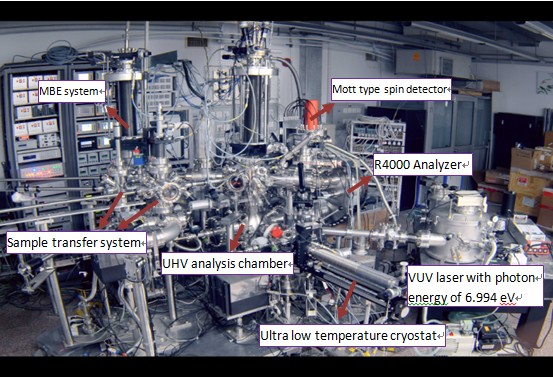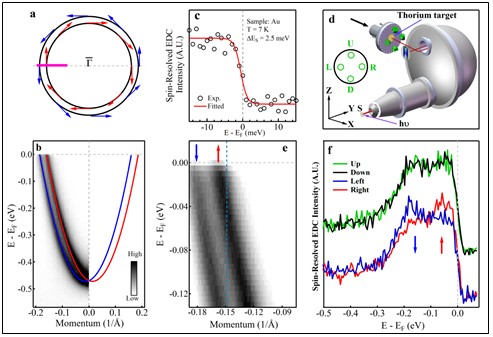
Fig.1 Picture of the VUV laser-based spin- and angle-resolved photoemission system (SARPES).
Materials properties are primarily determined by their electronic structures, which are described by three freedoms, namely, energy (E), momentum (k), and spin (s). Angle resolved photoemission spectroscopy (ARPES), which can measure the electrons’ energy and momentum simultaneously, has been proved to be the most direct tool to investigate electronic structures of materials. It has been developed into a precise and successful technique over the last several decades and established as one of the leading experimental methods in the study of the solid state physics, in particular, high-Tc superconductors [1]. However, the spin degree of freedom in solids, which becomes increasingly significant due to rapid development in both fundamental studies and potential application, especially for the emerging technology called spintronics [2], is missed in the regular ARPES measurements. Spin-resolved photoemission spectroscopy (PES) is usually difficult to achieve high resolution due to the inefficiency of spin polarimeters. The energy resolution of spin-resolved PES by using Mott detectors was reported to be around 70 meV [3, 4] and only recently was push to around 8meV [5]. An effective way to improve the energy resolution of the spin-resolve PES is to use high brilliance light source to compensate the low efficiency of spin polarimeters.

Fig.1 Picture of the VUV laser-based spin- and angle-resolved photoemission system (SARPES).
We have successfully developed the first VUV laser-based SARPES system by combining the Scienta R4000 (upgrade to DA30 recently) with two perpendicularly installed retarding type mini Mott detectors (see Fig. 1). It can carry out regular ARPES and spin-resolved measurements simultaneously and determine 3D spin polarizations.

FIG. 2: The VUV laser-based spin- and angle-resolved photoemission system (SARPES) and its measurements on the Au(111) surface state. The best spin-resolved energy resolution is around 2.5 meV by measuring the Fermi edge of a clean polycrystalline Au at 7 K.
High energy resolution of 1 and 2.5 meV for regular ARPES and spin-resolved measurements, respectively, has been achieved. Its superior performance has been verified by measuring the spin polarization of surface state of Au (111). Figure 2 shows the performance test results of the SARPES systems. The instrument resolution for spin-resolved measurements was estimated to be around 2.5 meV by measuring the Fermi edge of polycrystalline gold as was shown in Fig.2(c). This is so far the best energy resolution achieved for a spin resolved photoemission spectroscopy. We also performed spin- and angle-resolved measurements simultaneously on Au(111) surface states, which has a unique spin texture due to Rashba effects as shown in Fig.2 (a) and (b) [6,7]. The surface bands image mapped by regular ARPES and spin-resolved energy distribution curves (EDCs) obtained by the horizontally installed Mott detector at the same time are presented in Fig.2 (e) and (f), respectively. The remarkable intensity difference around binding energy of 0.16 and 0.05 eV between the left and right channels reveals the spin polarization along Z direction (parallel to sample surface) of the related surface bands. On the other hand the EDCs recorded by the up and down channel are nearly identical to each other implying that there is no out-plane spin polarization for Au(111) surface bands. Moreover, the spin-resolved EDCs from the up and down channels show clearly two well separated peaks located around binding energy of 0.16 and 0.05 eV, respectively, which has not been resolved for spin-resolved measurements so far in previous reported results. This fact indeed demonstrates not only the high energy resolution but also the high angle-resolution of our SARPES system. Our spin-resolved experimental results on Au(111) surface state are coincident with theoretical calculated results[8].
1. A. Damascelli et al., Rev. Mod. Phys. 75, 473 (2003)
2. S.A. Wolf et al., Science 294, 1488 (2001)
3. S. Qiao et al., Rev. Sci. Instrum. 68, 4390 (1997)
4. M. Hoesch et al., J. Electron Spectrosc. Relat. Phenom. 124, 263(2002)
5. S.Souma et al., Rev. Sci. Instrum 81, 095101 (2010)
6. S. Lashell et al., Phys. Rev. Lett. 77, 3419 (1996)
7. G. Nicolay et al., Phys. Rev. B 65, 033407 (2001)
8. J. Henk et al., J. Phys:Condens. Matter 16, 7581(2004)